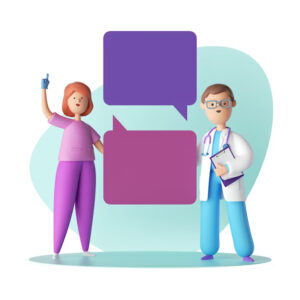Explaining complex medical concepts to patients has always been an art form 3D Animation. As a doctor, you have the unenviable task of taking complicated ideas and procedures and making them clear and concise for people who likely need medical training. It takes work. But new technology is helping change that. 3D animation and virtual reality revolutionize how doctors and medical organizations communicate with patients and the public.
Why 3D Animation Is Effective for Medical Communication
Explaining complex medical topics to patients and their families can be challenging. But 3D animation is an effective visual communication tool that helps make these conversations more engaging and easier to understand.
3D animation allows you to create a virtual experience demonstrating how anatomy, physiology, diseases, and treatments work. Patients can see detailed visual representations of the body’s organs, tissues, and systems. Furthermore, they clearly understand how blood flows, the lungs inhale oxygen, or how a surgical procedure is performed.
Seeing is understanding. 3D animation taps into our visual-spatial skills, allowing us to comprehend spatial relationships and mentally manipulate objects in three dimensions. We process visual information 60,000 times faster than text and remember 95% of what we see and hear.
You can walk through a 3D animation slowly and deliberately, giving viewers time to absorb details. To highlight particular attention, use callouts. In addition, Add text descriptions and audio narration for context. Zoom in on areas of interest for a closer look. Play and replay as needed.
Helpful For Patients To Control Anxiety
3D medical animation helps patients feel more at ease by knowing what to expect before a procedure or treatment. It gives them a sense of control and helps alleviate anxiety from not fully understanding their condition or care plan.
The power of 3D animation lies in its ability to visually demonstrate the unseen. It brings to life anatomical structures, physiological processes, and the intricacies of the human body in an engaging, informative way. When used to communicate health topics, it leads to better understanding and outcomes.
How 3D Animations Help Doctors Explain Complex Topics to Patients
When doctors have to explain complicated medical conditions or treatment options, 3D animations are invaluable. They provide a visual representation that helps patients understand in a way that words alone often can’t.
3D animations allow doctors to walk patients through procedures step-by-step. They can rotate, zoom in and out, and highlight specific parts. This helps give patients a transparent mental model of what will happen during surgery or what a condition looks like inside the body.
Helpful In Demonstrating The Details Of Patient Health Complexity
These visuals also facilitate an understanding of complex anatomical relationships and biological processes. It’s one thing to describe how blood flows through the heart, but seeing an animated model in action conveys the concept more intuitively.
3D animations are also helpful in demonstrating how devices like stents, joint replacements, or other implants will function once inserted into the body. Patients can understand how these technologies will impact and interact with their anatomy to improve health and quality of life. However, to get more information on healthy lifestyles, check out the article on What Drink Is Best To Cleanse Your System and learn ways to improve your body’s health.
In some cases, 3D animations may help patients decide on a particular course of treatment. When people can visualize options and better grasp the pros and cons of each, they feel more confident about the decision-making process and choice.
3D technology has revolutionized medical communication. It bridges the gap between complex ideas and human understanding, empowering patients with visual knowledge about their health.
Examples of 3D Animation in Healthcare Education
The trend of utilizing Professional 3D Animation Services is increasing in healthcare education as it provides an engaging way to explain complex topics and procedures. Some examples of how 3D animation is enhancing medical communication include:

Surgical Techniques
Ever wondered how hip replacement surgery is performed? 3D animations demonstrate surgical techniques in a detailed yet easy-to-understand fashion. They provide an “inside look” into the operating room, showing how surgeons gain access to joints and muscles, the tools and implants used, and how everything fits together. These animations are invaluable for educating medical students and preparing patients before a procedure.
Cellular Processes
The microscopic world inside our bodies is brought to life through 3D animation. Things like how neurons fire, the steps of cell division, and the complex mechanisms within our cells can be modeled and animated. So this helps make the theoretical concepts from textbooks more concrete and memorable.
Anatomical Models
Rather than static diagrams in a book, 3D animation allows for interactive anatomical models. Layers can be peeled away to reveal deeper structures, and models can be rotated and viewed from any angle. This provides a better understanding of the different components of bodywork in three dimensions.
Virtual Reality (VR)
The ultimate immersive experience is provided through virtual reality. VR applications use 3D animation to transport users inside the human body. You can explore the brain, circulatory system, or other areas in a truly immersive fashion, which is not possible any other way. Moreover, VR is poised to revolutionize medical education with its unparalleled capacity for realistic simulation.
3D animation, especially with technologies like VR, makes healthcare topics more accessible and engaging for all. Its use in medical communication will continue to expand in the coming years to benefit professionals and patients alike.
What to Look for in a Professional 3D Animation Services Studio
When looking for a 3D Animation studio to bring your medical concepts to life, there are a few key things to consider.

First, look for a studio with experience in the medical field. Consequently, creating animations for medical education and communication requires understanding anatomy, physiology, and the ability to visually represent complex ideas accurately. Make sure that the Professional 3D Animation Services Studios has a proven track record of high-quality work for doctors, hospitals, medical device companies, and pharmaceutical companies, who will have the necessary expertise.
You’ll also want to evaluate their creative skills and style. Do their animations strike a balance between engaging and informative? Do they have experience crafting spirits in the style you’re looking for, realistic, stylized, or somewhere in between? Review examples of their work to get a feel for their abilities.
Consider The Technology And Software They Use
Industry-leading 3D animation software like Maya, 3ds Max and Cinema 4D allow for high-quality, realistic results. Also, look for studios versed in specialized medical animation software which provides pre-built anatomical models and assets. Using the proper tools and technology is vital to achieving medical accuracy and realism.
Good Communication And Project Management
Remember to consider the importance of good communication and project management. Look for a studio that asks many questions about your needs, goals, and target audience. They should provide frequent updates, check-ins, and opportunities for feedback as your animation progresses. Solid communication at every project stage will help ensure a result that meets your expectations.
Pricing And Turnaround Times
Lastly, look at their pricing and turnaround times. High-quality medical animation can have longer timelines and higher costs due to the required research, details, and revisions. Ensure you understand all costs upfront and that the studio can complete your project within your timeframe. If time is limited, be open to focusing on critical sections rather than trying to convey too many ideas in a single animation.
With some research, you can find a 3D animation studio able to craft an accurate, impactful animation for your medical communication needs. In the same way, focusing on their experience, skills, technology, communication, and pricing will help determine if they fit your project.
Conclusion
Ultimately, medical animation and 3D visualizations are changing the game regarding educating patients and improving health literacy. Additionally, they provide medical professionals and doctors with new tools that can show you precisely what’s happening in an entertaining and easy-to-understand way. When your doctor asks you through the process or issue, don’t be shocked when they bring up animation videos to bring the information to life.



















